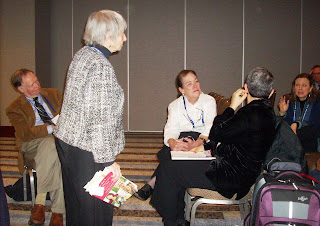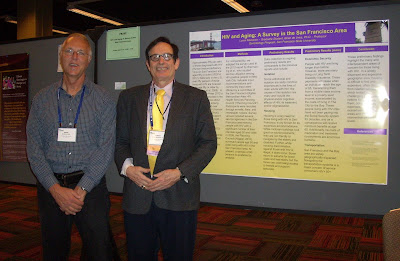Living retirement with purpose
Monsignor Charles Fahey and Bay Area-based aging marketer Ken Dychtwald shared their views of Transforming Retirement: Timing, Roles, Funding, Challenges/Opportunities and a New Purpose. Fahey summed up retirement as time to use energies we have and accept limitations, set relationships right, forgive and be forgiven. Dychtwald reviewed five stages of retirement
 |
1. imagination: 15-5 years before retirement
2. anticipation: 5-0 years before retirement
3. liberation: living the dream honeymoon lasts one year
4. reorientation: 1-15 years after retirement, characterized by asking who am I now?, growing concern about health problems and insufficient savings
5. reconciliation: trying to come to terms with entire lives, anxiety about cost of living, legacy
According to Dychtwald, retirement needs to go beyond self-indulgent R&R, away from mindless leisure entitlement of 1970s, to live with higher purpose and contribution. This new definition of retirement means staying engaged, re-invention and freedom to reflect/sleep/play/maybe work. Our lives are no longer based on a shared linear timetable focus on education, work & family, and then leisure—but now they happen throughout our ”cyclic lifeplan.”
Dychtwald returned with his power point in New Vision for 21st Century Aging: Five Course Corrections Needed for a Century of Healthy, Active and Successful Aging (Policy & Advocacy), which repeated much of his earlier presentation: re-set markers of aging; foster healthy aging; financial wake-up call; institute flexible life scheduling; and catalyze marketplace.
I found it disconcerting to watch a Big Pharma commercial before a panel appeared on Leadership for Global Population Aging (which might be a reason why I can’t remember the names of the two men seated on the left in photo, other than one was from a multinational retailer and the other from Big Pharma). Beginning in the middle seat is Michael Hodin (former Big Pharma exec and now Global Coalition on Aging Executive Director), Joyce Gallagher (Chicago Area Agency on Aging Executive Director) and John Beard (World Health Org Director of Age-ing and Life Course).
When the retailer asked, what’s the new 65 or retirement age? Beard quickly responded that there was no fixed or defined age because our transformed life course demands a flexible approach. Gallagher said physical disabilities make one feel age so we must invest to maintain independence but not isolation, and view aging as a continuum focused on what we are able to do; for example, one could be age 13 online when we don’t see the person :-) She talked about identifying people who need help via “boots on the ground”—from sandwiched caregivers of parents and kids, who are never off their mind so they can’t be fully focused without respite services and employer caregiver support beyond FMLA, to isolated older adults who become curmudgeon hoarders because they don’t want their independence taken away and need to be brought back into society. Beard offered an Asian solution where older people form self-help groups for mutual care and support.
Dying your way
The conference’s general sessions tended to be upbeat discussions about longevity, so it was refreshing to attend What is Person- and Family-Centered Care (PFCC) and What Happens When We Fail to Provide It? session focused on end-of-life care.
The conference’s general sessions tended to be upbeat discussions about longevity, so it was refreshing to attend What is Person- and Family-Centered Care (PFCC) and What Happens When We Fail to Provide It? session focused on end-of-life care.
Lynn Feinberg, formerly with Family Caregiver Alliance in SF and now AARP Senior Policy Advisor, introduced PFCC as culture shift in the delivery of LTC that addresses an individual’s needs, goals, values, preferences, cultural traditions, family situation, etc. (see http://www.aarp.org/relationships/caregiving/info-03-2012/moving-toward-person-and-family-centered-care-insight-AARP-ppi-ltc.html). Compassion & Choices Chief Program Officer Mickey MacIntyre (wearing bowtie) discussed why patient-centered care does not include unwanted treatment and why it’s important to ensure the full range of medical treatments are available to patients, improve quality of these discussions between patients and health professionals, ensure compliance with advanced directives and Patient Self-Determination Act (see Good to Go resource guide at http://community.compassionandchoices.org/document.doc?id=425).
Passages author Gail Sheehy shared her own experiences with end-of-life care for her late husband.
Tongue-in-cheek
The Second City skits included improv musical of audience-inspired Granny Lost Her Depends!
The Second City skits included improv musical of audience-inspired Granny Lost Her Depends!
Moody at last!
I admit that I’m a bit of a Moody groupie, after studying his textbook last semester and meeting him at the last GSA meeting. (About 10,000 of Moody’s friends, including myself, stay in touch with him by subscribing to his free e-newsletters at http://www.hrmoody.com/newsletters.html.) At GSA, Moody didn’t prepare any power point presentations and sitting in his workshops were more like salon gatherings. Of the six workshops at ASA involving Moody, I was able to attend three:
Ethics and Aging in the 21st Century (Policy & Advocacy) workshop focused on caregiving with perspectives from Martha Holstein, Larry Polivka and Rick Moody. Holstein challenged the myth that women are natural caregivers who actively choose that role, because the lack of alternatives results in the exploitation of women, who are expected to be super-Samaritans who drop everything to become full-time caregivers, and their marginalization in public because their duties are performed at home. Polivka criticized privatization and the commoditization of LTC as threatening the quality of TLC in the community, reminding us that nations fail when we move from institutions of inclusion (social welfare) to extraction (predatory Wall Street). Moody saw basis for hope in the moral economy, where we act collectively to leave a legacy of caring for the future.
Longevity and Wisdom (Spirituality & Religion) workshop with Robert Weber, Andy Achenbaum and Rick Moody, explored the question: Why did I live so long? When Weber asked what were our hopes in coming to this workshop, one woman answered for me when she said she knows she can learn a lot from Moody and Achenbaum. Philosopher Moody responded to the workshop’s question based on his recent experience of caring for a dying 98-year-old friend, who asked a similar question (why does it take so long to die?): “for people to come to thank you, so I could meet you, and then stay with each other because we will not always have this time together.”
The Invisible Face of Aging: Can We Look in the Mirror? with Connie Goldman and Rick Moody. When someone in the audience asked how can we combat ageism, Moody responded: “Change the word.” He explained that he submitted workshop called Invisible Face of Ageism, but “Ageism” changed to “Aging” in all the conference materials.
Helen Kivnick from the audience spoke about co-authoring Vital Involvement in Old Age with Joan and Erik Erikson while they were in their 90s, so she’s had positive views of old age.
Goldman mentioned that health becomes more important as one ages, so she goes to the Y in the morning and pays more attention to what she eats because”your body is like a car.” Huh? At this point, I will interrupt coverage of the conference to share this health promotion announcement because I thought about my friend’s book titled, Your Body Is Not a Car (http://almondpublishing.com/docs/Your_Body_Is_Not_A_Car_excerpt.pdf). In his book, Hoenie explains you can’t repair your body as casually like a car: 1) your body can’t be fixed by replacing defective parts like a mechanic does a car (organ transplants aren’t so easy), and 2) your body stays with you for your whole life so to keep using the same body, you can’t rely on quick fixes that don’t address the root causes of health problems.
Going green
During a perfectly timed break between workshops, I stepped out of the windowless conference rooms for some fresh air . . . and to see Chicago River dyed green as part of St. Patrick’s Day celebration, a tradition since 1962 (http://greenchicagoriver.com/story.html)!
Finally, I attended conference’s last workshop, War on Ageism: The Human and Economic Consequences. Irene Nielsen discussed ageism from a terror management perspective, which posits that "mortality salience" increases in-group favoritism, so do the old fail to identify with their own group resulting in prejudice? When she asked us to fill-in-blanks to COFF_ _, I immediately thought COFFEE. Was my failure to think COFFIN a denial of old age/death? I think not, as I'm just more obsessed about food than death. Another presenter talked about being physically active to stay “young” as if she meant to stay “healthy” as we age?
March is National Nutrition Month (http://www.eatright.org/nnm/), so I enjoyed Good Food Festival (http://goodfoodfestivals.com/) at U of Illinois-Chicago campus before heading over to airport.
At the airport, age has its privileges: kids age 12 and under can keep their shoes on during airport security check, but passengers age 70+ can keep both their shoes and jacket on during screening.
Save the date
Save the date
ASA will celebrate its 60th anniversary at the 2014 Aging in America Conference in San Diego































